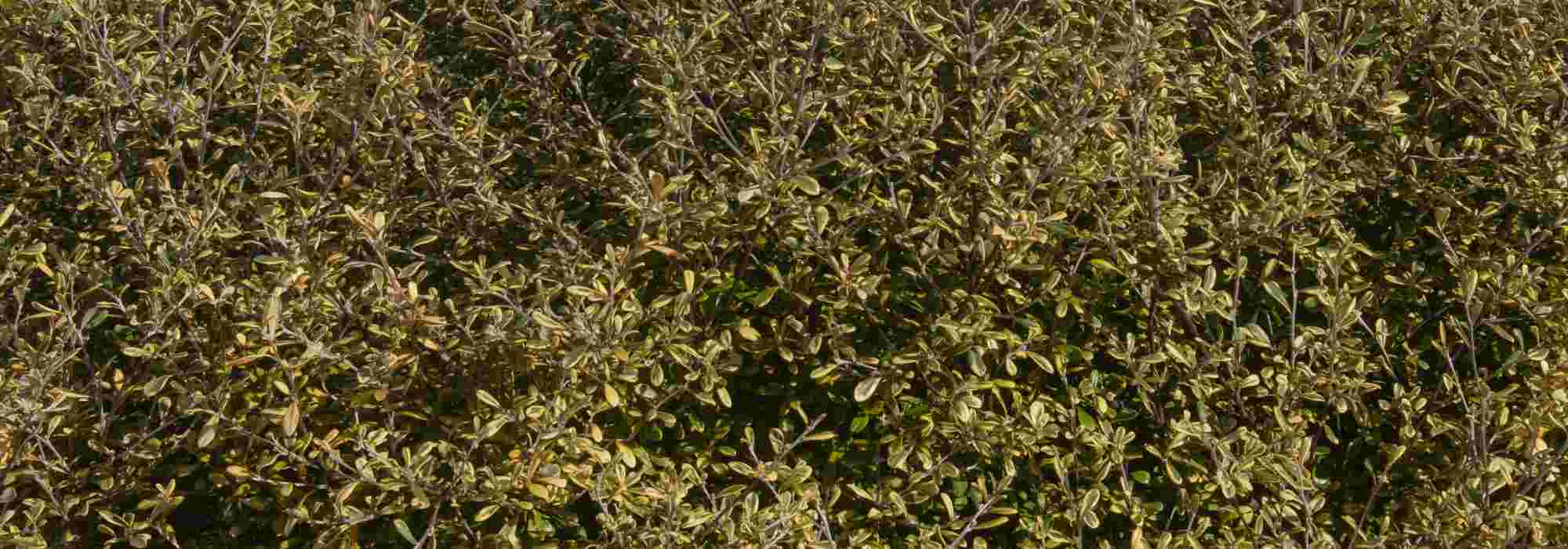
Corokia: planting and care
Contents
Corokia in a few words
- The Corokia is an evergreen bush with tangled, zigzag branching.
- It bears small, glossy leaves in varied colours.
- It produces fragrant, small yellow star-shaped flowers, followed by decorative red or yellow berries in winter.
- Moderately hardy, it can be grown in the ground in mild regions or in pots elsewhere.
- It thrives in coastal areas, in low hedges, whether free-growing or pruned.
The word from our expert
The Corokia or corokie is a little-known New Zealand evergreen bush, characterised by fine, black zigzag branches. Its dark, tangled-looking branches are adorned with small, glossy leaves in varied hues, and in spring, they are covered with a shower of pale yellow, star-shaped, melliferous, and fragrant flowers. This early and abundant flowering is followed by colourful winter berries that are highly decorative.
Measuring less than 2.50 metres in height, it has an unusual charm, much like the Corokia (x) virgata ‘Frosted Chocolate’ with its chocolate-coloured, frosted foliage in winter. There are even very compact varieties that do not exceed 1 metre in height in any direction (Corokia (x) virgata ‘Banana Royal’, Corokia cotoneaster ‘Little Prince’).
Moderately hardy, it is best planted in a pot that can be sheltered from severe frosts in colder regions. Tolerant of poor soil, resistant to drought and sea spray, this original bush is ideal for coastal gardens spared from heavy frosts. Depending on your region and its size, it can be used as a low hedge, free or pruned, as ground cover, in pots, or even as a bonsai.
Discover without delay this uncommon bush that brings originality and colour to your garden or terrace all year round!
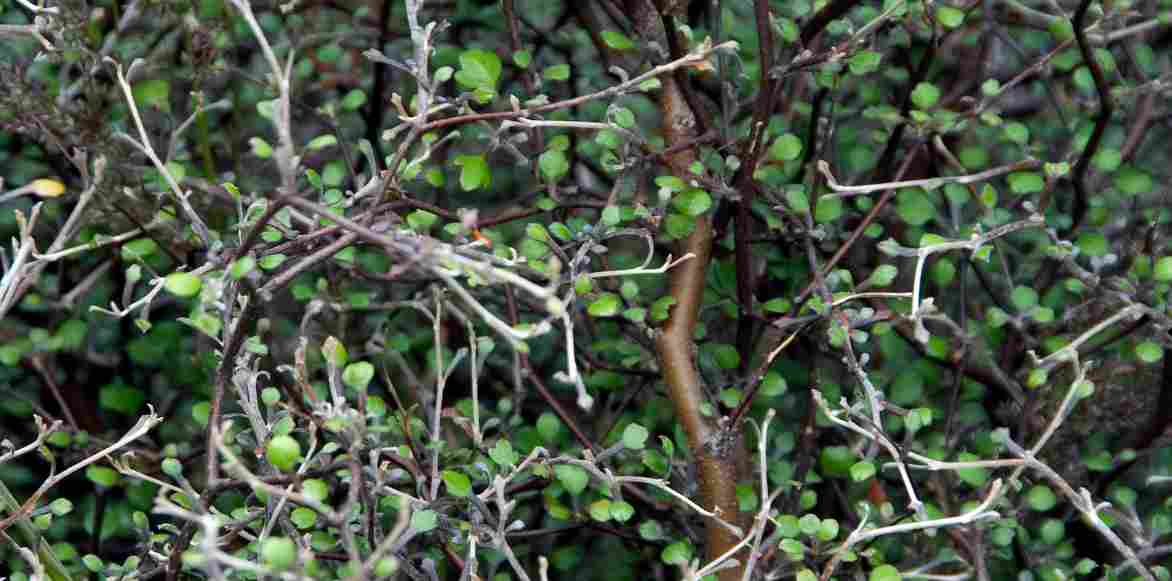
Corokia cotoneaster
Description and Botany
Botanical data
- Latin name Corokia
- Family Corokiacées
- Common name Corokie
- Flowering April-May
- Height 1 to 3 m
- Exposure Sun, partial shade
- Soil type Light, rich, well-drained
- Hardiness -5-10°C
The Corokia or corokie is an evergreen bush belonging to the Argophyllaceae or Corokiaceae family, depending on the classification. It originates from rocky coastal areas, plains, and forests of New Zealand, always in a rather dry climate, not too humid. The Corokia genus includes about ten species, among which the Corokia cotoneaster is the most well-known. You can also find the Corokia (x) virgata, a hybrid, and its many cultivars with beautiful coloured foliage, such as ‘‘Frosted Chocolate’ or ‘Banana Royal’, or the Corokia buddleioides, also known as the buddleia-leaved corokia.

Corokia cotoneaster Botanical plate
These bushes are characterised by a dense, bushy silhouette with tangled branches, giving them a wild appearance. Most are distinguished by the unique architecture of their thin, black, angular branches that grow in a zigzag pattern (divaricate plant), a particularly common trait in New Zealand’s flora, signifying adaptation to dry and sunny climatic conditions, much like its waxy leaves. The plant’s graphic appearance is enhanced by the black colour of its bark. C. buddleioides stands out with its straight branches.
This bush forms a fairly compact shrub, about 1 to 3 metres tall, depending on the variety and growing conditions. Its growth is relatively slow.
In the Corokia, the main appeal lies in the diversity and appearance of its foliage. On this zigzagging branchwork, foliage develops that remains evergreen if the winter is not too harsh. The black bark, woolly on young shoots, offers lovely colour contrasts with the leaves. The shapes and colours of the leaves vary depending on the cultivar.
Small, waxy, and spatulate (spoon-shaped), oval to obovate, measuring 0.5 to 4 cm long, the leaves alternate sporadically along the mesh of the branches. They are rounder in the Corokia cotoneaster ‘Little Prince’, narrower in the Corokia (x) virgata ‘Banana Royal’, and felted with white in the species type. They resemble those of the Buddleia (butterfly bush) in the Corokia buddleioides. They thicken and darken in winter. They display varied colours ranging from silvery green to dark green tinged with purple, through light yellow, green streaked with pink, copper, or frosted chocolate. Shiny on the upper side, they are covered with a felt-like texture underneath. The whole forms a bush with a very distinctive graphic charm.
Flowering occurs from May to June in the form of a shower of fragrant stars. Clustered in bouquets in the leaf axils or solitary, small flowers 1 to 2 cm in diameter with five petals dot the branches. They emit a light fragrance. They are very melliferous and attract pollinators. They are followed by small ovoid drupes in fiery tones of red, orange, or yellow, reminiscent of the berries of the Cotoneaster. They persist during the cold season on the branches, delighting birds and adding colour to the garden in winter.
In its native regions, the Corokia cotoneaster is used to stabilise sand dunes.
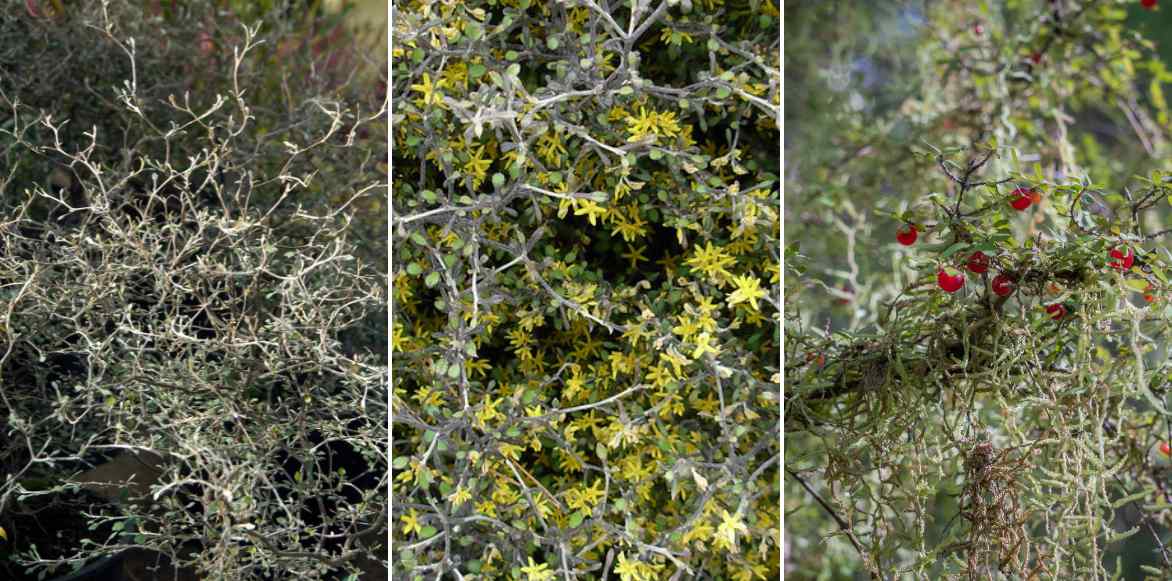
On the left and centre, Corokia cotoneaster habit and flowering (© brewbooks). On the right, the berries of a Corokia ‘Red Wonder’
Main species and varieties
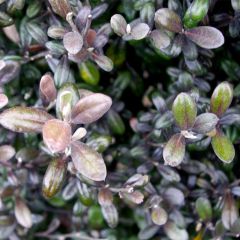
Corokia virgata Frosted chocolate
- Flowering time June
- Height at maturity 2 m
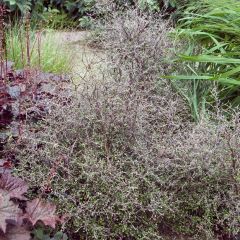
Corokia cotoneaster
- Flowering time June, July
- Height at maturity 2,50 m
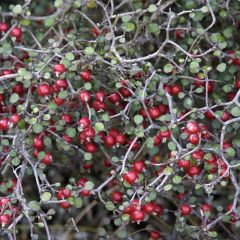
Corokia cotoneaster Little prince
- Flowering time June, July
- Height at maturity 1,50 m

Corokia virgata Banana Royal
- Flowering time June
- Height at maturity 1 m
Discover other Corokia
View all →Available in 1 sizes
Available in 1 sizes
Available in 1 sizes
Available in 1 sizes
Planting Corokia
Where to Plant It?
From its New Zealand origins, the Corokia has retained a preference for mild climates. Not very hardy, it can only be grown in the ground in regions with mild winters, primarily near the coast, in gardens spared from severe frosts. It can tolerate cold temperatures down to -5-10°C. In regions with harsh winters, smaller specimens can be grown in pots on terraces or balconies and sheltered indoors during winter in a cool, bright, unheated room.
It compensates for its relative sensitivity to cold with good drought resistance and tolerance to salt spray once well-established. It is an ideal bush for coastal gardens and dry gardens. It is perfectly suited to gardens along the oceanic coastline of our country but also tolerates Mediterranean summers fairly well if given occasional but thorough watering. Undemanding, it adapts to all types of soil, even poor and chalky, as long as it is well-draining, as it dislikes waterlogged roots. It will thrive in fertile, light soil, not too dry but rather fresh and well-drained. Plant it in full sun for abundant flowering or in lightly shaded areas in the south of our country.
Versatile, it lends itself to various uses depending on your climate. Near the coast, it can be planted in an open area, as a standalone feature or in a free or trimmed hedge, exposed to salty winds. A gravel bed or even a slope where it will help retain soil will also suit it. Elsewhere, give it a spot sheltered from cold, drying winds, in a shrub bed or against a well-exposed wall to protect it from severe frosts.
Its slow growth makes it perfectly suited to pot cultivation, ideal in cold climates. Low-growing forms will thrive in pots on a terrace, make excellent ground cover, or can even be trained as bonsai.
When to Plant Corokia?
The best time to plant Corokia is in spring, outside periods of frost or drought. In mild climates, autumn planting from September to November is also possible.
How to Plant It?
In the Ground
This bush simply requires well-draining soil, as it dislikes clayey or waterlogged soil in winter. In water-retentive soil, opt for planting on a mound.
- Dig a hole at least twice the size of the root ball (about 40 cm in all directions)
- Add a 10 cm layer of pumice or gravel at the bottom to improve drainage
- Mix garden soil with compost or potting soil and a little sand
- Plant and backfill around the root ball without burying the branches
- Firm the soil and water
- Spread a mineral mulch to keep the base cool in summer
In a Pot
- Choose a large container of about 30 litres
- Add a generous layer of drainage (gravel or clay pebbles) at the bottom of the pot
- Plant in a well-draining mix of potting soil and river sand
- Water regularly, but avoid overwatering
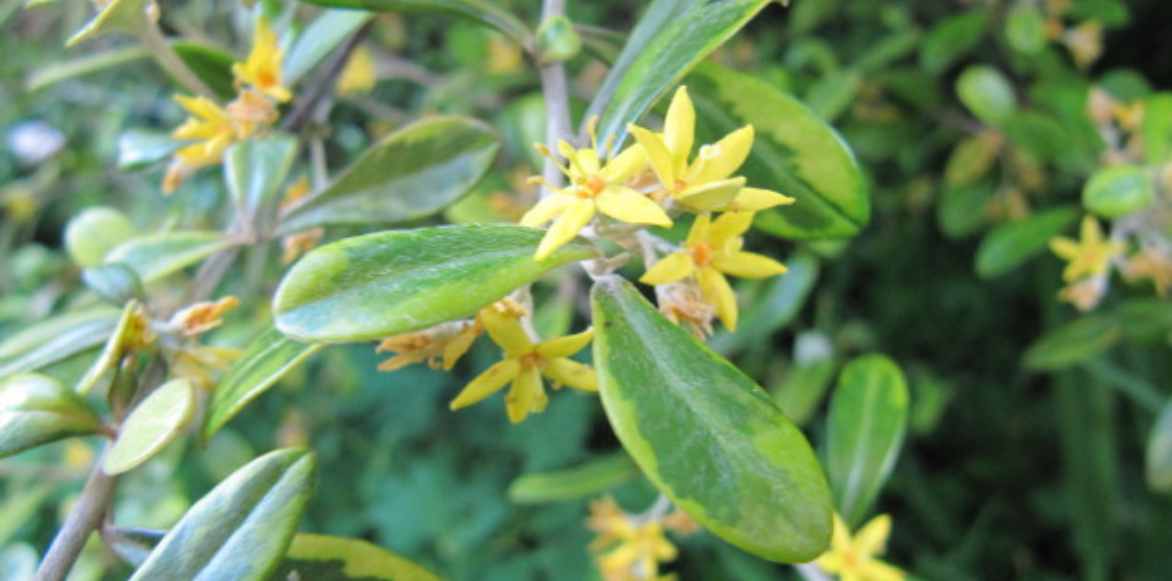
Corokia ‘Sunsplash’ (© Leonora Enking)
Maintenance, pruning and care
The Corokia is an easy-to-grow bush in mild climates that requires no special maintenance. Monitor watering during its first few summers to aid establishment. Once well-rooted, it becomes drought-resistant, provided the soil remains cool at depth. A few infrequent but thorough summer waterings, once or twice a month, will suffice. In pots, its water needs increase: water as soon as the surface soil dries out.
Add compost or well-rotted manure by lightly scratching it into the base in autumn to encourage growth. For potted plants, fertilise with organic or slow-release fertiliser in autumn. Repot or top-dress every 2 or 3 years.
In colder regions, as the first frosts arrive, mulch the base generously with straw or dry leaves and remember to move pots into a frost-free, well-lit area.
Hardy, the Corokia is unaffected by diseases or parasites.
How to prune the Corokia?
Pruning involves maintaining a balanced shape: lightly trim any branches that disrupt symmetry to preserve the decorative fruiting. Prune after flowering, in August-September. More severe pruning is possible to control growth or rejuvenate the young plant.
Multiplication
The propagation of corokia can be done by propagation by cuttings or sowing, with the first method being the quickest and simplest.
Propagation by Cuttings
Semi-hardwood cuttings are best taken in July-August.
- Take semi-ripe stems, 10 to 15 cm long
- Cut just below a node
- Remove the lower leaves and keep only two pairs of upper leaves
- Plant them in a well-draining mix of sand and compost
- Keep the substrate moist until rooting occurs
- Place your cuttings in a humid environment
- Transplant into pots and then into the ground the following spring
- Water well during the first year after planting
Sowing
The seeds require cold stratification to germinate.
- In late autumn or winter, sow in pots filled with a well-draining seed compost
- Keep outdoors and maintain the substrate moist throughout germination
- Once the seedlings have emerged, move them to a sheltered spot away from frost
- Plant them in their final location the following autumn
Associate
Versatile, the Corokia can be used in free or pruned hedges, as ground cover, low hedges, slopes, or in large, low-maintenance shrub beds, or even to create bonsai. This is an original bush for creating a permanent display in mild climates. With its graphic silhouette and drought tolerance, it fits well in a dry Mediterranean garden or a contemporary-style setting.
On a slope, it can be paired with the creeping juniper ‘Blue Star’, or with Ceanothus Thyrsiflorus Repens. It can also accompany heathers, whose long flowering period spans all seasons, or grasses with complementary shapes. In a bed of easy-care shrubs for mild climates, pair it with Buddleias, rockroses (Cistus laurifolius), Fremontodendron californicum, the evergreen Ceanothus ‘Puget Blue’, or an Olearia scillonensis.
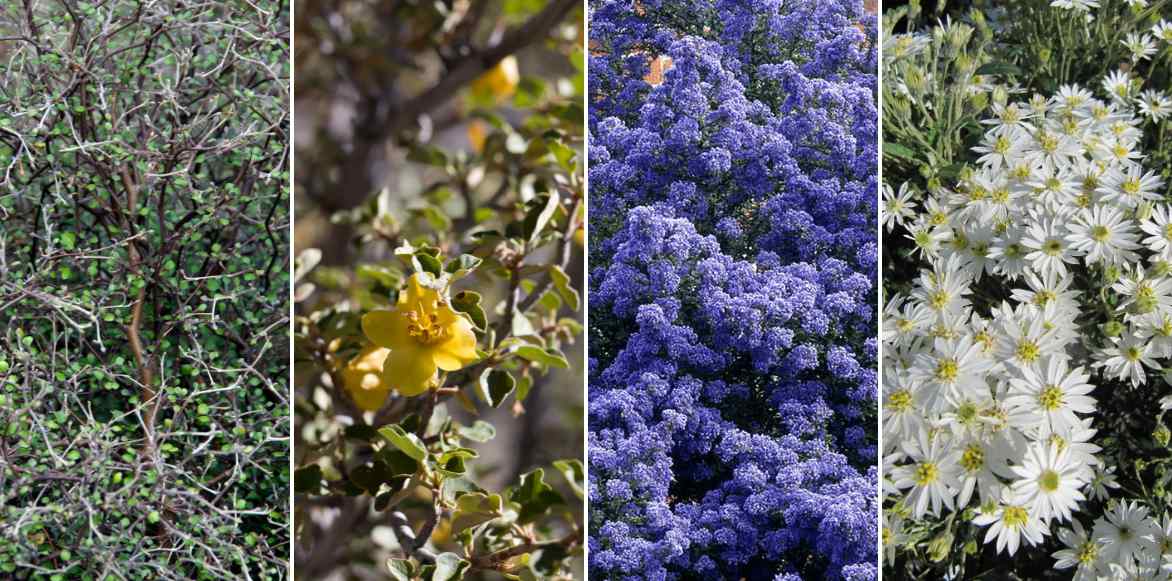
Corokia cotoneaster, Fremontodendron californicum, Ceanothus ‘Puget Blue’ and Olearia scillonensis (© Leonora Enking)
By the sea, it can be paired with ballota and phlomis, both with velvety foliage. In a low hedge, it can be combined with other small evergreen bushes like Leptospermum (Nanum Tui, Martinii, Silver Sheen). In a mixed hedge, plant it alongside other beautiful shrubs such as Hippophae rhamnoides, Pyracantha, Cotoneaster, and strawberry trees.
It can also be grown in large containers on a terrace or balcony, paired with dwarf conifers or other small bushes to create unusual evergreen screens.
Useful resources
- Using evergreen bushes in the garden
- Subscribe!
- Contents



































Comments